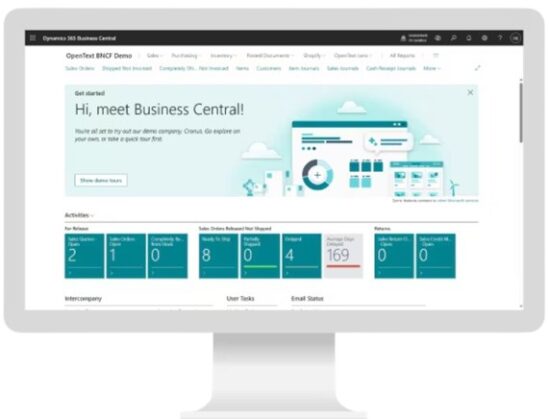opentext Dynamics 365 EDI Integration

Introduction – A Need For Customizable Unified Integration
Integrating data from supply chain transactions across applications and systems is vital for most businesses. In many cases, these integrations involve the organization’s Enterprise Resource Planning (ERP) systems, such as those from Microsoft Dynamics 365® ecosystems, which are central to automating business processes and providing visibility into operations. In other words, a unified integration strategy is necessary.
Failing to integrate ERP as part of an overall system modernization puts organizations at a disadvantage in today’s dynamic digital landscape. A fragmented approach hinders cost optimization, innovation, and differentiation. Many businesses turn to low-cost pre-built ERP integration adapters.
Unfortunately, those are often too rigid and not sufficiently customizable to support all requirements, enable agility, and scale with business growth.

Finding the right balance between centralized control and flexibility is key to ensuring day-to-day business needs are met while building agile internal capabilities for efficiently managing dynamic integration requirements.
Partnering with a trusted vendor with expertise for customization and offerings that include low-cost customizable adapters with managed services can solve the problem.
Options For Integrating Microsoft Dynamics 365
Dynamics 365 provides native integrations within its cloud application ecosystem, allowing seamless interoperability and sharing of common data elements. Third-party integration platform vendors also offer pre-built connectors for popular business applications that manage the underlying complexity in a standardized and well-governed manner. Some even commercialize them on the Microsoft AppSource marketplace.1 However, while native and pre-built connections may able to provide some improvements, their capabilities are lacking in real-world supply chain scenarios.
Recommended Dynamics 365 integration strategy
Many organizations find pre-built integrations insufficient for their complex and digital processes. Integrating beyond these limitations demands a modern platform and specialist expertise to handle intricate data transformations, validation, and quality control. This is especially true for external data sources, where an “ERP firewall” is crucial to mitigating data issues originating outside the organization’s control.
Beyond technology, proper integration governance is vital. Organizations solely relying on external consultants and system integrators often face a highly fragmented and costly integration solution portfolio. This often involves maintaining custom code and point-to-point integrations across disparate platforms, leading to documentation challenges and business impacts beyond IT.
Having a solid integration strategy that enables flexible, scalable, and costefficient delivery across use cases is critical. Leverage Dynamics 365’s native capabilities, but complement them with a solution that fills specific gaps without resorting to multiple tools and platforms.
Use case: Integrating Dynamics 365 Business Central to enable O2C automation
As an example of common integration flows that require adaptation and specialist skills, consider automation of an organization’s order-to-cash (O2C) process when using Dynamics 365 Business Central.

Overview
In this example, a consumer packaged goods (CPG) company is using Dynamics 365 Business Central as its ERP system. To streamline its O2C process, the company automates inbound purchase orders and outbound sales invoices with a key retailer. Additionally, it sends warehouse shipping orders directly to a 3PL provider from within Dynamics 365 Business Central.
Purchase orders and invoices
- Purchase orders are received as EDI messages (e.g., ANSI X12 850 or EDIFACT ORDERS) from the retailer via an SFTP connection.
- The integration platform translates these messages into Dynamics 365’s native JSON format and passes them to the system using the Common Data Service (CDS) API.
- Business users create invoices in Dynamics 365, triggering an integration flow that communicates the invoice data in JSON format to the platform.
- The integration platform validates and transforms the invoice data into an EDI document (e.g., ANSI X12 810 or EDIFACT INVOIC) preferred by the retailer.
- Finally, the integration platform delivers the EDI invoice to the retailer over the SFTP connection.
Warehouse shipping orders
- Submitting a shipping order in Dynamics 365 triggers an integration flow that delivers the order data in JSON format to the integration platform using the CDS API.
- The integration platform transforms the JSON data into an EDI message (e.g., ANSI X12 940) preferred by the 3PL provider.
- Depending on the provider’s preferences, the integration platform delivers the EDI message over AS2 or another chosen protocol.
User interaction
Business users can access real-time information and process status through Dynamics 365 system dashboards and reports. An integration visibility tool embedded within the Dynamics system provides detailed information about the overall process and individual messages, offering a real-time view of data flowing through the platform.
Additional Integration Considerations
- O2C process automation often includes complementary data flows, such as confirmations, shipping notifications, status updates, and remittance advice, which further enhance the process.
- Managing integrations with hundreds of customers and numerous logistics providers requires a scalable and flexible integration solution.
- Dynamics 365 customers can leverage Power Automate, a built-in integration platform, or a cloud-based integration platform-as-a-service (iPaaS) solution.
- Maintaining consistent integration development practices, such as documentation and testing frameworks, and ensuring proper monitoring and error resolution processes are crucial for successful implementation.
- Access to skilled integration experts is essential. Organizations can consider leveraging strategic partners to extend their internal IT capabilities.
- Scalability is vital to avoid costly platform replacements. OpenText™ Trading Grid™, a unified cloud integration platform, is designed to accommodate growth and changing business needs.
Figure 1: Sample integration flows between Dynamics 365 and external systems to enable O2C process automation.

Opentext Integration Solutions
OpenText provides a single, unified integration environment that allows companies of any size to seamlessly integrate with more than one million preconnected trading partners. The range of partners spans suppliers, logistics carriers, distributors, and financial institutions located anywhere in the world. Simplifying and accelerating digitization and optimization of information flows provides a scalable digital foundation for business growth.
All OpenText integration solutions leverage OpenText Trading Grid, a modern, unified cloud integration platform. Organizations are able to select the right capabilities to meet their current requirements with the option to later add capabilities and scale up data volumes without needing to migrate to a new platform. The platform also offers powerful self-service features, such as prepackaged partner kits and connectors for Microsoft Dynamics 365 systems and other ERPs. Together, this functionality and tiered system allow an optimal cost structure while future-proofing the solution for business expansion, M&A activities, or other major changes scope and scale.

Conclusion
While Microsoft Dynamics 365, along with other ERP vendors, strives to facilitate seamless interoperability through pre-built integrations, these often fall short in delivering the desired process automation and data consistency across an organization’s broader system. Today’s ERPs typically require adaptation to integrate with traditional systems, particularly those used by ecosystem partners. Technology alone is insufficient; to succeed, it must be wielded by skilled experts following defined processes.
Both technical capabilities and integration operations need to scale in tandem with the business. Focusing solely on current requirements lacks foresight.
Business growth objectives and their potential impact on future needs must also be considered.
A successful integration strategy enhances agility, accelerates project delivery, and lowers the total cost of ownership across integration solutions.
Learn more about OpenText™ B2B Integration Foundation for any size business
Learn more about OpenText™ B2B Integration Enterprise for highly complex integrations

Documents / Resources
 |
opentext Dynamics 365 EDI Integration [pdf] User Guide Dynamics 365 EDI Integration, Dynamics 365, EDI Integration, Integration |



